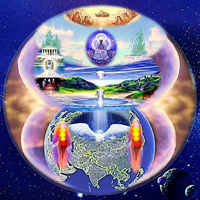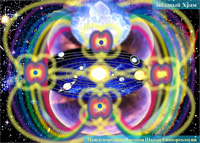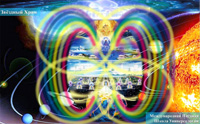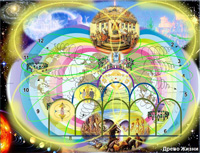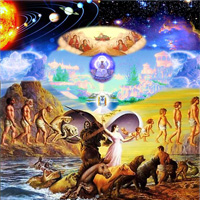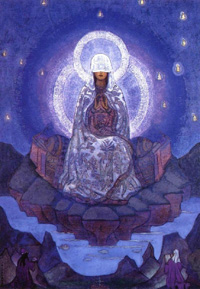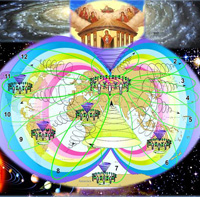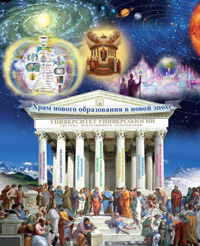Calendar
| Mo | Tu | We | Th | Fr | Sa | Su |
|---|---|---|---|---|---|---|
| 1 | 2 | 3 | 4 | |||
| 5 | 6 | 7 | 8 | 9 | 10 | 11 |
| 12 | 13 | 14 | 15 | 16 | 17 | 18 |
| 19 | 20 | 21 | 22 | 23 | 24 | 25 |
| 26 | 27 | 28 | 29 | 30 | 31 |
Moon Phase

Banners
| The law of duality - the law of polar interactions |
|
(The law of unity and struggle of the opposites)
Pesina Tatyana I., candidate of technical sciences.
The unity of the world manifests through the infinite variety of life forms and, above all, through the dualism of all things. It is important to examine the different facets of the duality of the law. 1. Each system of life, every phenomenon is inherent dualism, duality, in other words, availability of a pair of opposites, polar origins: “+” and “-” good and evil, light and darkness, spirit and matter, masculinity and femininity, evolution and involution. 2. Each polar sources, in turn, is of a dual character. According to K. Jung, in a masculine origin there is always a feminine (anima), and in the feminine there is a masculine (animus). In the ancient symbol of dualism inyan, on the black part there is a white dot, and there is a white one on the black part; in other words, each of the opposite sources has the potential of the other (Fig 1. u, с. 5); a masculine also contains feminine hormones and a feminine contains masculine ones. 3. The world is infinitely differentiated in accordance with the levels of consciousness; both the scope of reasons and the scope of consequences are differentiated as well. One may ask - why is that so? - in order for the matter of each level to have its own creative impulse, that is, “each has his or hers” and everything develops in accordance with its consciousness. A creative impulse (spirit, beam) is differentiated into subrays until and in the way the matter of each level of consciousness receives the information and the developmental momentum it is able to absorb. Additionally, the creative impulse rushes and finds exactly the matter which it is able to stimulate, the one that has reached a certain level of excellence and is able to respond to the interaction. This is how Virgin Mary was supposed to emerge, a matter of such extraordinary purity and perfection that can interact with so high a spirit that Jesus had a chance to be born. He was a son of a human, but he was destined to become a son of God. There is infinity of causal relationships that determine different levels of consciousness and different energy plans of life (space-time continua). The relationship between them is based on the law of polar interactions. Separating cause and effect, systems and subsystems, spirit and matter is relative, as the cause is regarded only for a particular consequence. There is always a bigger reason for which a certain one is only a consequence. Therefore, any system of life is also the reason relative of a subsystem (a smaller system or a part of it) and a consequence relative of a super system (a larger system which constitutes the system). For a human, a larger system is a group, for a group it is a society, for a society it is the humankind, and for the humankind it is the planet. In this way exists a chain of continuous development, which reminds of a human spine (a person’s inner core), the core of the Caduceus (a symbol of eternal and continuous development), or the double helix of the DNA (the basis of life). A vivid illustration of the infinity of development and of the fact that a super system exists is a mathematical theorem of Kurt Gödel’s incompleteness, the essence of which is the following: each sufficiently powerful, formally logical system (theory) contains such consistent provisions, which can neither be proved nor disproved only by its internal means. This can be performed only at the level of the super system. In other words, there should always be a super system; hence comes a conclusion of the following: - forms of matter, life forms are never ending - consciousness is infinite - development is infinite 4. The opposites do not exist without each other, they are in a permanent relationship, the essence of their unity. Opposites are inseparable, as it is impossible to separate the two sides of the same coin, the two poles of a magnet - they cannot exist without each other: no matter in how many parts one tries to divide a magnet, there will always be the north and south poles. Plato said the following of the unity and struggle of the opposites, “Existence is singular and plural, it is permanent and transitory, it is static and changeable, and it rests and moves. Contradiction is a necessary condition for the soul’s stimulus to thinking.” Eliphas Levi said the following, “A binary is a unity split in two by its own power to create.” Helena Roerich wrote about the fact that “the world is kept in balance is demonstrated by opposing forces”: “The visible world is based on the bipolarity of all that exists. The action of the opposites produces harmony, like the centripetal and centrifugal forces, which, being mutually dependent, need each other for existence. If one stops acting, the action of the other will be devastating.” A well-known saying attests to the indissoluble unity of the opposites: “Good and evil do not exist without one another. They are in everything, like “yes” and “no”, light and shade, sound and echo. There is no such thing as just “evil” or “good”; everything has two ends of one Source.” 5. There is always tension between the polar sources - a conflict, which promotes interaction and which is the source and the driving force of any development. Development is a movement from one level of consciousness to another. Involutionary development is moving from a larger to a smaller level of consciousness. Evolutionary development is moving from a smaller to a larger level of consciousness. Development is known to have both an evolutionary (creative) and involutionary (destructive) orientation. Evolutionary development requires conditions for harmonious cooperation, which will make it control the lessening of tension and lead to minimizing the conflict and stabilization. The rise of the third source is the result of this interaction of polar sources. The third source is the center of emission, which becomes independent and more energy-intensive, potentially more perfect than are its “parents”, which is expressed in its ability to reach a qualitatively new level of development. Children must be better than their parents, as a new level of integration - it is always potentially a new level of capabilities, otherwise, there is a risk of degradation and degeneration of society. Everything in this world develops through the interaction of polar sources and after the rise of their third. In this way trinity arose: spirit - soul - identity father - son - mother reason - the transformation of the (transient) - a consequence Thus, the tension between the polar sources creates the desire for balance and harmony. However, the balance and harmony achieved are relative because they in turn are only transient in multi-level systems and the beginning of new polarization. In case the conditions of a harmonious interaction or the conditions for the evolution of the situation are missing, the development takes an involutionary direction. Then the events become destructive. If the situation gets out of hand and becomes uncontrollable, the destruction can be immense. Lack of momentum transfer medium may serve as an example of the lack of conditions for harmonious interaction. As is known, if there is no environment between the poles of an insulator and a conductor, as the voltage between the poles of the medium increases, breakage is inevitable, which can lead to its destruction. This shows how important it is to form a conducting medium between the polar sources. There are two types of interaction between the polar sources, two kinds of polarization: horizontal and vertical. Horizontal polarization: - interaction of single-level systems - in the same space-time continuum - synergetic interaction - based on the principle of complementing the missing developmental experience This is an interaction between the electron and proton, between atoms, people, groups, planets, or stars. Vertical polarization: - the interaction of different levels of systems - in different continua - hierarchical interaction - based on the principle of matching vibration levels of cause and effect: 1 7; 6 - 2; 5 - 3 This is an interaction of people → a group, a group → society, a society → humankind, humankind → planet, Earth → the solar system, etc. Hierarchical (vertical) interaction is always the interaction between the system and a subsystem. In reality, both hierarchical and synergetic interactions occur simultaneously. Therefore, the development occurs in a spiral. For example, the interaction between a team and person is hierarchical or multilevel. At the same time, the interaction of the members of this team is on a synergy or one-tier. During an interaction both elements improve: - the larger system gains experience by interacting with the smaller one. It learns to manage the development in growing space in less time, while its power consumption increases. - the smaller system improves as well. It learns to perceive more subtle and higher control action, rising in its development on the path of evolution. Not only does the basic quality of each polar source improve, but also its dual manifestation, which is contained in each of them. Thus, there is a mutual, two-way improvement process: - the larger system learns not only to manage, but also to receive (“Only a person who knows how to report can be a good leader”). - the lower system learns not only how to obey, but also how to manage the development of its smaller systems (“He is a poor soldier who does not dream of becoming a general”). 6. The larger system sets a program development for the smaller one, which is based on universal laws and is a synthesis of plurality of different levels of experience of living systems. The larger system encourages the development of the smaller one, directing it in the most effective way. The goals of the smaller system must be coordinated with those of the larger one. The efficiency of the smaller system’s development is determined by how well its objectives and criteria interact with those of the larger system. First, those qualities of the smaller system that are indispensable for the larger one are stimulated for the development. Thus, for example, the cancer cells in the body that are trying to work “on themselves” are not stimulated to the development. In the case of a healthy immune system, cells are isolated and removed as slags. On the other hand, the development of those cells, organs, and systems, which are actively involved in the metabolism of the whole body is stimulated (“If a son shall ask his father for a piece of bread, will the latter offer him a stone?”) Similarly, in the human triad spirit-soul-personality, the spirit that manifests itself through the soul, plays the leading role, but the soul acts through the person. At the same time, personality must improve in order not to be distorted through the life of the soul. In any group, the people who have been most useful to the team are valued the most. Only the company whose aims and whose products meet the objectives of the evolutionary development of society will develop steadily and efficiently. Only a country whose developmental priorities correspond to the universal aims and values, will become a country of freedom, equality, and fraternity. Only when humankind does not think only of itself, but also cares for the other estates of nature and when the objectives of its development correspond to the evolutionary developmental goals of the planet will it fulfill its purpose. It is important to examine the manifestation of the law of polar interactions in various fields of human activity and in different areas of knowledge.
1. In philosophy Pairs of opposites: - cause - effect - content - form - general - private - single - individual - universal - unique - perfect - material - new - old - absolute - relative The main question of philosophy is - what comes first the mind or matter? The law of unity and struggle of opposites is one of the three basic laws of dialectics: - each object embodies the opposites; dialectics considers the opposites as relationships, which, on the one hand, are a inseparable unity, but, on the other, are mutually exclusive - there is no unity without the opposites, and there are no opposites without the unity - the unity of opposites constitutes a contradiction - a contradiction is the main category of the dialectics; it is an internal source and the driving force of development Socrates built his famous dialogues on resolving contradictions. By asking questions, he showed the contradictions in the arguments of the interlocutor. Socrates believed that by disclosing this contradiction, the imaginary knowledge disappears, and anxiety, where the mind delves, forces a person to search for the truth.
2. In anatomy There are two hemispheres of the brain, two arms, two legs, two ears, two eyes, two nostrils, or two lips. Humankind is now going through the development in the second solar system, which is why duality is presented so widely.
3. In physiology Dualism of physiological processes: - redox processes in the cells - excitement vs inhibition in the cerebral cortex - contraction vs muscle relaxation - inhaling vs exhaling - arterial and venous circulation - the acid-alkaline condition in the digestive system - male and female sex hormones - absorption and allocation in the excretory system People interact with the world around them by way of energy bodies - horizontal interaction. The experience of interaction is going to the energy center and is transmitted from the torsion box over to the head - vertical interaction.
4. In sports Athletes who continually raise the bar in their aspirations are familiar with power struggle, conflict, thus each time renouncing previous achievements, even though perfect at the moment. Each mountain climber will mention stress, for climbing is possible only by overcoming gravity.
5. In the field of health improvement and sickness prevention In order to stimulate the body’s immune system, doctors do not recommend bringing fever down to a certain limit. Surgeons do not prescribe a prolonged bed rest after surgery. It is common knowledge that the health of a body depends on alternating voltage and discharge. However, keeping a body healthy does not constitute a feature of a healthy body, but a sign of a pathology. Only when it is sick, the body seeks for ways to avoid stress. Hans Selye wrote the following on the duality of stress manifestation, “Complete freedom from stress is death. We must not, and cannot, avoid stress. Yet, we can use it if we learn its mechanism and develop an appropriate philosophy of life.” Depending on the attitude to stress, its effects can be either detrimental or beneficial. Since stress is a requirement for restructuring in accordance with a situation, which accompanies any activity, only an idle person is able to avoid stress. The basis of the concept of recovery is the thesis, “A sickness is a repressed life of the soul and unrealized human creative abilities.” A sickness is the result of a defective interaction of human energy with the outside world, or distortion of horizontal interaction, and with the power grid of the planet, or distortion of vertical interaction. Thus, the defective energy exchange and the suppression of the life of a soul is the cause of sickness, and sickness itself is its consequence. Therefore, “a healthy mind in a healthy body” is not a true statement, because in fact, a healthy mind creates a healthy body, since the spirit is reason, and the body is a consequence.
6. In the area of management The basic principle of forming managed systems is minimizing a conflict that occurs when subject-object relationships are not aligned. If there is no connection between a cause and effect, or no conductive medium, a conflict occurs when the “lower classes do not want to live in the old way”, and the “tops cannot govern in a new way.” The evolutionary theory of management as a field of causes must be perceived and accepted by the management entities, which act as the scope of consequences. Then a development may be controlled, which gives rise to minimal systemic relations and conflicts management that allow forming the conditions for a qualitative upgrade of system relations.
7. In psychology Pairs of opposites: - object - subject - reflection - ransformation, or two stages in the process of learning - an analysis-synthesis, or two functions of thinking: analytical and synthesizing - rational - irrational - conscious - unconscious B. Frankl believed that “a healthy dose of stress is a necessary attribute of humanity and is necessary for mental well-being.” In psychology, the three-factor theory of development is based on the notion that there are three main factors of personality development: biological, or hereditary, social, and active interaction. Yet, universology substantiates the fact that at the initial stage the biological factor prevails, but as consciousness develops, the importance of biological factors weakens, but that of social ones increases. In psychology, the cultural-historical concept of L. Vygotsky examines the duality of human existence, which is the individuality of each person and its manifestation in line with the unity of the historical process as a whole. While studying consciousness as a product of social and historical development, L. Vygotsky justifies the fact that a person is determined by the social relations and, at the same time, affects them. In terms of universology, the duality of the nature of consciousness constitutes the fact that consciousness is both a result of interaction between an object and subject, and at the same time, the factor that determines the level of interaction and quality of follow-up activities aimed at the transformation of the psychological system, in which the subject is manifested.
8. In physics Polarity of the electric and magnetic fields is “+” and in electricity “-“, the north and south poles of a magnet. Huygens’ principle is a principle of cooperation in compliance with vibration. The duality of the nature of light is light as a particle, or corpuscular theory of light, and light as a wave, or the electromagnetic theory of light. Their joint development resulted in the quantum theory of light.
9. In the sign system “-” is a symbol of horizontal polarization, “+” is a symbol of the completeness of the interaction and the presence of horizontal and vertical polarization. At the same time, “+” is the symbol of a cross, crucifixion; once complete interaction has been achieved, a transformation of relations occurs, the transition to the construction of a new life system (Fig. 1.4).
10. In fairy tales There is a constant struggle between the good and evil there. A vicious wolf that chases either a rabbit or three piglets, or seven baby-goats symbolizes evil; the same wolf keeping order in a forest symbolizes duality. In his tale “The Tale of Tsar Saltan”, A. Pushkin, a famous Russian poet, puts forward the idea of priority: Which bride will the king choose? - the one who demonstrates her willingness to realize his program - “to beget a son”, in other words the one that acts as the matter, her purpose, the host, and begets the spirit of the program.
11. In proverbs and sayings “There is no wrong without good” - manifestation of duality; “Birds of a feather flock together”; “Show me your friend, and I’ll tell you who you are” - horizontal polarization; “A holy place is never empty” - vertical polarization; “The way to the stars is through thorns” - trials and tribulations precede the rise of a new quality
12. In the Bible God made every creature in pairs, which is manifestation of duality. “Let a wife hold on to her husband, and they will become a whole” - unity of opposites; “The two will be together one will be taken, and the other will stay.” - separation of the level of experience; “Love your neighbor as yourself”, “Love your enemies as yourself” - horizontal polarization. The first and fundamental commandment: “Thou shalt love the Lord thy God with all thy heart, with all your soul and mind” - vertical polarization.
13. In the way of Christ Jesus - Judas; Christ - Antichrist - both two poles and both are equally necessary to create tension that made the transformation possible. At Calvary Christ unites Mother Mary and disciple John as a symbol of matter and soul, a symbol of the future era of unity of soul and personality.
14. In the work of the group A group of like-minded creative team is a positive point for the world, a coordinating council is a center for a group, a group coordinator is a center for a coordinating council. The duality of each person in a group manifests as a bright personality and as part of a team. Both are equally important: it is important to know how well a person demonstrates his or her individuality; otherwise, a group will be weak and inexpressive. It is also important to fit in a group, to be a useful, necessary, be able, to stimulate and nurture the group’s creativity. “Forget yourself for the sake of yourself; nurture yourself for the sake of others.”
15. In the relationship between man and woman Masculinity is the spirit, the active sources directed outward, a positive momentum in the outside world, the one that sets the development program, and one that stimulates development. Femininity is a matter of accepting the beginning, synthesizing the beginning; it is deep inner work. If a man is a strategy, a woman is a tactic. A man’s purpose is spiritualizing, whereas a woman’s purpose is bearing.
A man’s purpose is: - to develop a program of development - to find the woman, the matter that will be ready to accept this program - to stimulate the creativity of woman
A woman’s purpose is: - to accept the man’s program - to implement it - to give birth to a new essence, a new quality - to adapt it to the conditions of the world, to implement the program in the world, full and undistorted - to gather experience of the program’s implementation, its best, most valuable features - to transfer this experience to the man to adopt a new program While creating a family, it is important to understand and take into account the purpose of men and women because it is not so easy to find a polar source. The tragedy of modern families often lies in the fact that a woman is not willing to learn how to nurture the momentum of a man. At the same time, the man does not seek to raise the level of consciousness in order to match the quality of the spirit, to be a greater system and promote the development of a woman. Yet, in this case, everything is relative. It is a common fact that the same life system can act as both a greater and smaller system and as both masculine and feminine, depending on where and how the life of the system is reflected. In this way, the soul inside a person always acts as a positive momentum, as masculine with respect to the individual. However, a person can be both a man and a woman. If a woman is more advanced and is creatively interacting with a less active man, she acts as a masculine creative momentum. Although in general, concerning other men and women close to her by vibrations, she remains feminine.
16. In pedagogy The primary task of a teacher is in a timely manner to set an actual task for a pupil at the level, which will stimulate learning. In fact, the wisdom of the teacher is to stimulate in a student’s soul a creative conflict, creative tension, which will contribute to the rise of new information within the old, which will allow the student to overcome the resistance of the old for the sake of the new. “Teacher - student” relationship in the process of education. A teacher is a positive impulse, the one who carries the development of a program. A student is the matter that a teacher intends to inspire. At this point, a teacher’s impulse must be great enough to deliver the lesson efficiently and help the students to reach a new level of creativity. Otherwise, he or she loses contact and control of the class. As a result, chaos occurs. Students begin to dictate their conditions. This means that the teacher’s energy level is not sufficient to spiritualize his or her students, so the teacher does not meet the standards of a positive center, at this point, concerning this group. |
